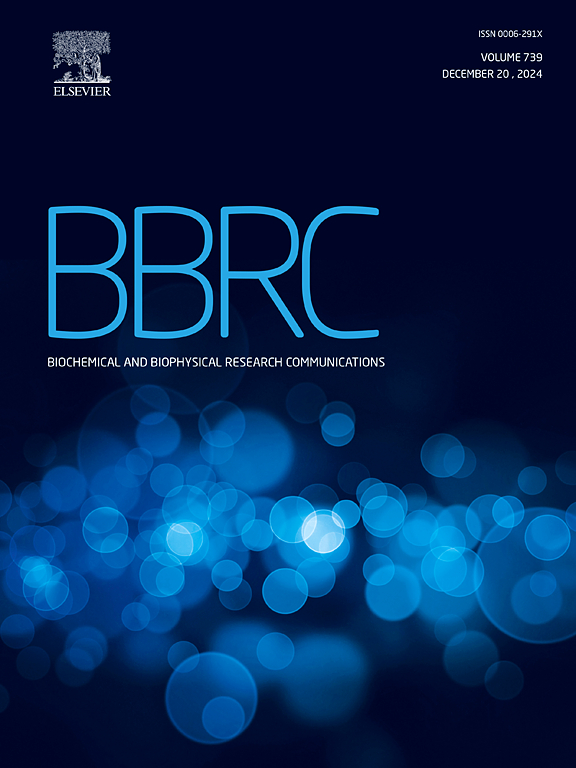MGAT3和MGAT5的过表达改变了转移性黑色素瘤细胞释放的细胞外囊泡的蛋白质货物
IF 2.5
3区 生物学
Q3 BIOCHEMISTRY & MOLECULAR BIOLOGY
Biochemical and biophysical research communications
Pub Date : 2025-04-02
DOI:10.1016/j.bbrc.2025.151749
引用次数: 0
摘要
细胞外囊泡(EVs)是潜在的非侵入性诊断、预后和治疗工具。此外,它们是肿瘤发生的重要贡献者。已经发现糖基化可以调节EV蛋白质组的组成。由n -乙酰氨基葡萄糖转移酶V (GnT-V)合成的β1,6支链n -聚糖的增加在黑色素瘤中最常见,并与细胞粘附降低和转移增加有关。n -乙酰氨基葡萄糖转移酶III (GnT-III)加入分割GlcNAc会产生相反的效果。迄今为止,这些酶对黑色素瘤中EV货物的影响仍未被探索。流式细胞术研究了诱导GnT-III或GnT-V编码基因(MGAT3或MGAT5)过表达的WM266-4黑色素瘤细胞遗传变异的表面糖基化以及这些细胞释放的ev。采用LC-MS/MS蛋白质组学分析糖基化改变对释放ev蛋白质组的影响,并进行详细的生物信息学分析。流式细胞术分析显示,过表达MGAT3或MGAT5的黑色素瘤细胞衍生的ev表面糖基化发生了动态变化。诱导过表达MGAT3或MGAT5也会引起ev蛋白组的显著变化。蛋白质组学分析共鉴定出1770种微泡蛋白和704种外泌体蛋白,这些蛋白在黑色素瘤的进展中起着不同的作用,包括那些具有确定的诊断/预后潜力的蛋白和那些与黑色素瘤发病密切相关的蛋白。过表达MGAT3和MGAT5的细胞衍生的EV的蛋白质组学分析显示,糖基化修饰驱动EV蛋白含量的功能变化。该研究提出了黑色素瘤源性EVs在诊断和预后方面的潜在多面应用。本文章由计算机程序翻译,如有差异,请以英文原文为准。
MGAT3 and MGAT5 overexpression alters the protein cargo of extracellular vesicles released by metastatic melanoma cells
Extracellular vesicles (EVs) are potential non-invasive diagnostic, prognostic and therapeutic tools. Additionally, they are important contributors to tumorigenesis. Glycosylation has been found to modulate the composition of the EV proteome. Increased amounts of β1,6-branched N-glycans, synthesized by N-acetylglucosaminyltransferase V (GnT-V), are most commonly observed in melanoma and are associated with decreased cell adhesion and increased metastasis. The opposite effect is caused by the addition of bisecting GlcNAc by N-acetylglucosaminyltransferase III (GnT-III). To date, the impact of these enzymes on EV cargo in melanoma remains unexplored. Flow cytometry was used to study the surface glycosylation of genetic variants of WM266-4 melanoma cells with induced overexpression of GnT-III or GnT-V encoding genes (MGAT3 or MGAT5) and EVs released by these cells.
LC-MS/MS proteomics was applied to analyze the effect of altered glycosylation on the proteome of released EVs, followed by detailed bioinformatic analysis. Flow cytometry analysis revealed dynamic changes in the surface glycosylation of EVs derived from melanoma cells overexpressing MGAT3 or MGAT5. Induced overexpression of MGAT3 or MGAT5 also caused significant changes in the proteome of EVs. The proteomic analysis identified a total of 1770 microvesicular and 704 exosomal proteins that play different roles in melanoma progression, including those with established diagnostic/prognostic potential and those closely associated with melanoma onset. Proteomic profiling of EVs derived from cells overexpressing MGAT3 and MGAT5 revealed functional changes in EV protein content driven by glycosylation modifications. The study presented a potential multifaced application of melanoma-derived EVs for diagnostic and prognostic purposes.
求助全文
通过发布文献求助,成功后即可免费获取论文全文。
去求助
来源期刊
CiteScore
6.10
自引率
0.00%
发文量
1400
审稿时长
14 days
期刊介绍:
Biochemical and Biophysical Research Communications is the premier international journal devoted to the very rapid dissemination of timely and significant experimental results in diverse fields of biological research. The development of the "Breakthroughs and Views" section brings the minireview format to the journal, and issues often contain collections of special interest manuscripts. BBRC is published weekly (52 issues/year).Research Areas now include: Biochemistry; biophysics; cell biology; developmental biology; immunology
; molecular biology; neurobiology; plant biology and proteomics

 求助内容:
求助内容: 应助结果提醒方式:
应助结果提醒方式:


